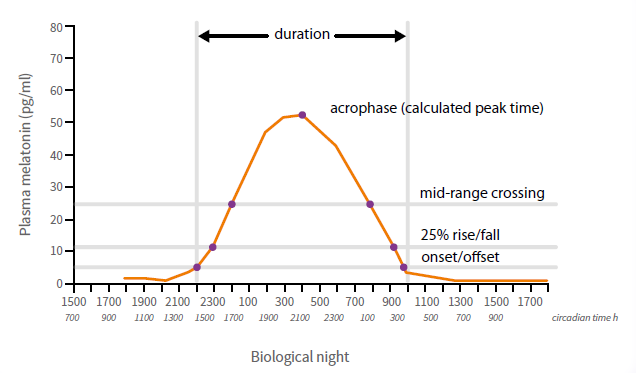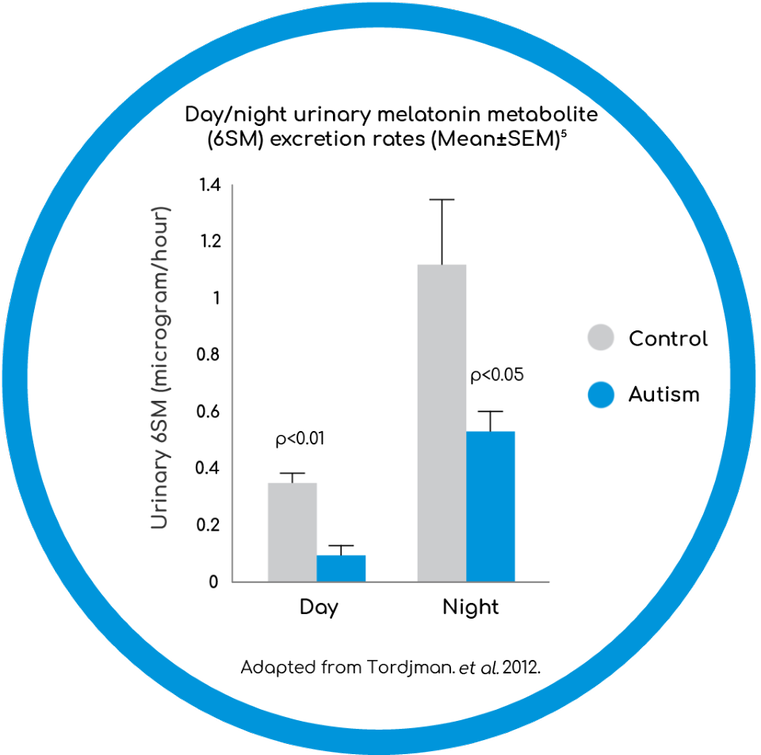Melatonin is a powerful antioxidant, involved in the regulation of circadian and seasonal rhythms and immune function.
Melatonin is released mainly by the pineal gland during the night and is produced by the conversion of serotonin to N-acetyl serotonin followed by the conversion of N-acetyl serotonin to melatonin by Acetyl Serotonin Methyltransferase (ASMT). Melatonin secretion is highly heritable in humans, modulates neuronal plasticity and regulates circadian gene expression.9
The physiological increase in melatonin secretion during the night is well established with a peak around 2am and night-time values are usually at least three times greater than daytime values. Pineal melatonin production is powerfully suppressed by light acting through the retinohypothalamic tract. In addition to light, and consequently seasonal affects, pineal melatonin secretion can also be influenced by endogenous factors including sex, age, and pubertal stage. The measures of melatonin concentration in plasma and saliva, or of the urinary excretion of its predominant metabolite, 6-sulphatoxymelatonin (6-SM), are considered the best peripheral indices of human circadian timing.11
Characteristics of the melatonin rhythm used to define timing of the internal clock.
Figure1. Adapted from Arendt, J., 201011
Melatonin is of interest in autism due to its apparent role in neurodevelopment, reports of sleep-wake rhythm disturbances in individuals with autism, and its beneficial effects when administered to individuals with autism and sleep problems. In addition, central and peripheral alterations in serotonin in autism have been widely reported and it is noteworthy that melatonin is synthesised in only two steps from serotonin in the pineal gland and the gut.10
Prior studies of melatonin production in ASD were often limited by small sample sizes and were equivocal, but all reported abnormalities in melatonin production. However, given the limitations of the available data, it is not possible to conclude if there is a general decrease in melatonin secretion during the whole 24-h cycle, or if the melatonin circadian rhythm is altered or inverted in ASD.
Figure 2. Adapted from Tordjman S, et al., 201210
Tordjman S, et al., (2012), reported a night and daytime deficit in melatonin production in a substantial proportion of individuals with autism (see Figure 1). The authors hypothesised that the small intra-individual night-time-daytime differences, and the significant absence of melatonin variation found in autism, might be a reflection of the lower day and night-time levels, or an indication that there exists a subgroup of individuals with autism that has a dysregulation of their circadian rhythm, and more precisely an absence of circadian rhythm.10
References:
9. Melke, J. et al. Abnormal melatonin synthesis in autism spectrum disorders. Molecular Psychiatry. 2008; 13:90-98
10. Tordjman, S. et al., Day and night-time excretion of 6-sulphatoxymelatonin in adolescents and young adults with autistic disorder. Psychoneuroendocrinology. 2012; doi.org/10.1016:1-8
11. Arendt, J. Occupational Medicine, Volume 60, Issue 1, January 2010, Pages 10–20. https://academic.oup.com/occmed/article/60/1/10/1439565
10. Tordjman, S. et al., Day and night-time excretion of 6-sulphatoxymelatonin in adolescents and young adults with autistic disorder. Psychoneuroendocrinology. 2012; doi.org/10.1016:1-8
11. Arendt, J. Occupational Medicine, Volume 60, Issue 1, January 2010, Pages 10–20. https://academic.oup.com/occmed/article/60/1/10/1439565



